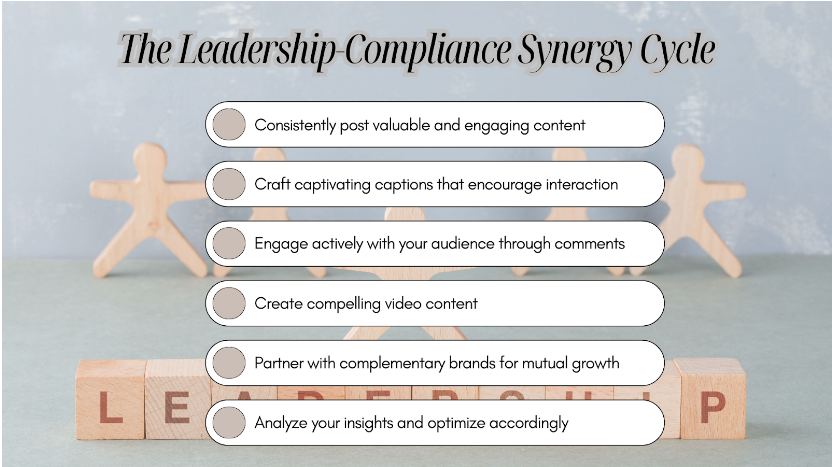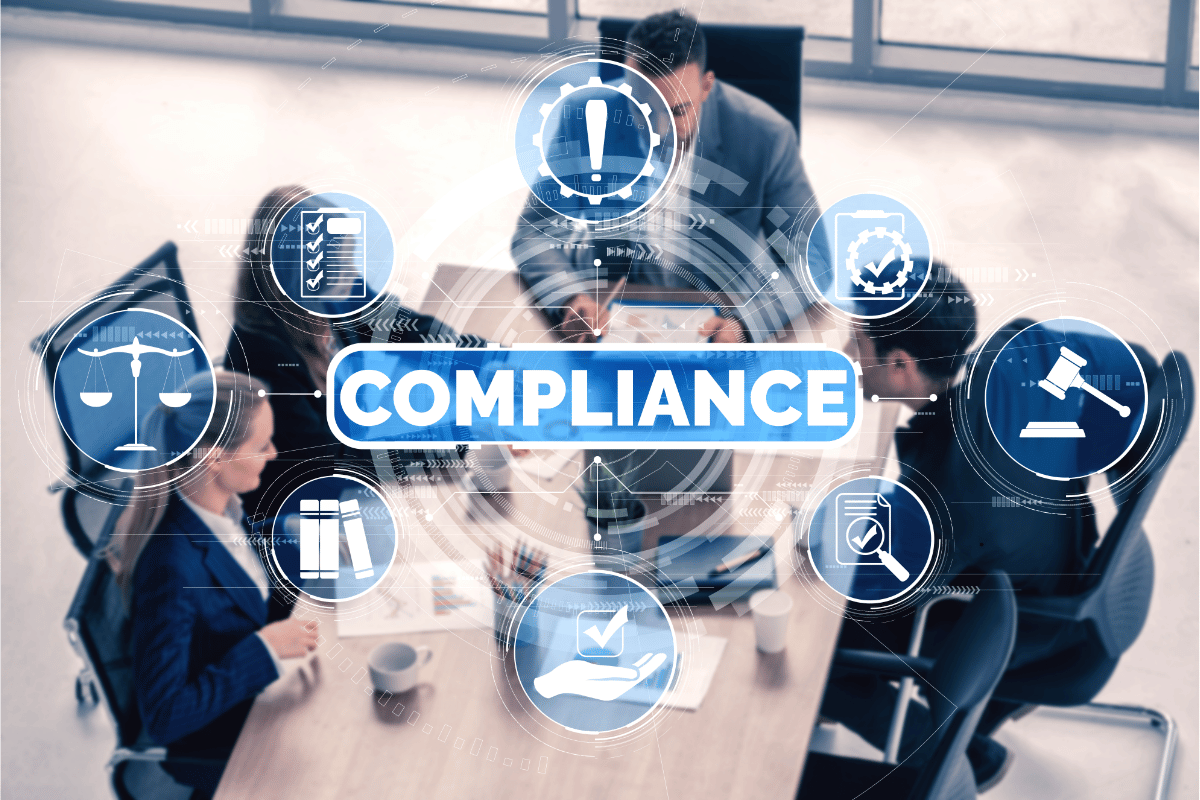Strong Leadership, Strong Compliance: A Strategic Partnership
In this article, we will explore the critical role of leadership in ensuring compliance, strategies for developing strong compliance leadership, challenges in aligning leadership and compliance goals, and the tangible benefits of a robust leadership-compliance partnership. Through this exploration, we aim to provide insights and practical guidance for organizations seeking to leverage the power of strong leadership to build a culture of compliance that drives sustainable success.
Introduction: The Power of Alignment
In the dynamic world of a company, one figure stands out: organizational leaders agree that adhering to compliance rules enhances the public’s perception of their company. This insightful statement highlights how important it is for modern firms to have a strong relationship between compliance and leadership. As companies navigate increasingly complex regulatory environments, it is more essential than ever for leadership and compliance to work together strategically.
This partnership promotes trust, propels organizational achievement, and improves overall corporate performance, in addition to ensuring that it meets legal and ethical requirements. This article will explore the intricate relationship between strong leadership and robust compliance, revealing the strategies, challenges, and benefits that arise when these two essential components align.
Strategies for Developing Strong Leadership in Compliance
Developing leaders who understand and prioritize compliance is crucial. “Strong Leadership, Strong Compliance: A Strategic Partnership” underscores the pivotal role of leadership in fostering a robust compliance culture within organizations. Effective leadership not only ensures adherence to regulatory standards but also integrates compliance seamlessly into strategic business objectives. By prioritizing transparency, accountability, and ethical practices, leaders cultivate a culture where financial compliance management solutions are embraced as essential tools for operational success.
Organizations can leverage technology for effective compliance leadership in two primary ways. First, by utilizing GRC (Governance, Risk, and Compliance) risk management software, they can gain comprehensive insights into governance landscapes. This software provides a holistic view that helps in understanding and managing various governance aspects efficiently. These technological advancements support compliance initiatives and provide leaders with data-driven decision-making and real-time insights crucial in today’s digital era.
The Role of Leadership in Ensuring Compliance
It’s crucial to embed compliance into all aspects of daily operations, not just focus on legal adherence. In practice, this involves several key steps: Resource Allocation—allocating sufficient funds for compliance initiatives to emphasize their importance; Clear Communication: leaders have to convey the value of compliance clearly and consistently; Leading by Example: executives must set an example of compliance through their actions and decisions; and Integration into Strategy: seeing compliance as a strategic asset rather than a liability.
Challenges in Aligning Leadership and Compliance Goals
Achieving smooth alignment is rarely easy, despite the many benefits of building strong leadership-compliance cooperation. Businesses that use cutting-edge GRC (Governance, Risk, and Compliance) software solutions can overcome these obstacles. By streamlining compliance procedures and improving visibility, these systems guarantee regulatory adherence throughout the company and offer real-time information. Regular forums between leadership and compliance teams additionally promote open discussion and agreement on compliance goals.
By taking proactive steps to address these issues, organizations can create a coherent compliance plan that supports their overall goals. Several common obstacles are highlighted by this misalignment: First, organizational culture-based resistance to change can hinder effective compliance efforts. Second, communication gaps between compliance teams and leadership often lead to misalignment of compliance goals and strategies. Additionally, competing priorities force managers to balance short-term business goals with long-term compliance objectives, while resource limitations, including insufficient funds and staff, restrict comprehensive compliance initiatives.

Benefits of a Strong Leadership-Compliance Partnership
When leadership and compliance work in harmony, the benefits ripple throughout the organization. Let’s explore some of the key advantages:
1. Enhanced Organizational Reputation
- Trust Building: Customers, investors, and regulators are just a few of the stakeholders who profit from a robust compliance culture that is led by the leadership.
- Competitive Advantage: Organizations known for their integrity often outperform their peers in the long run.
2. Improved Risk Management
- Proactive Approach: Leadership involvement in compliance leads to more effective risk identification and mitigation strategies.
- Reduced Incidents: A culture of compliance typically results in fewer regulatory violations and associated penalties.
3. Operational Efficiency
- Streamlined Processes: When compliance is integrated into operations, it often leads to more efficient, standardized processes.
- Cost Savings: Avoiding compliance-related issues can result in significant cost savings in terms of fines, legal fees, and reputational damage.
4. Innovation and Growth
- Ethical Innovation: A strong compliance foundation can foster innovation by providing clear boundaries within which to operate.
- Sustainable Growth: Compliance-aware leadership is better equipped to guide the organization through expansion into new markets or product lines.
5. Employee Engagement and Retention
- Clear Expectations: Employees appreciate working in an environment where ethical standards are clear and consistently applied.
- Pride in Organization: A strong ethical culture can boost employee morale and loyalty.
Comparison: Traditional vs. Leadership-Driven Compliance Approaches
To illustrate the impact of leadership on compliance, let’s compare traditional and leadership-driven approaches:
| Aspect | Traditional Compliance Approach | Leadership-Driven Compliance Approach |
| Focus | Rule-based, reactive | Value-based, proactive |
| Implementation | Siloed, compliance department-centric | Integrated across all departments |
| Communication | Top-down, infrequent | Open, continuous dialogue |
| Training | Generic, periodic | Targeted, ongoing |
| Technology Use | Basic reporting tools | Advanced GRC and risk management software |
| Risk Management | Reactive, incident-based | Proactive, strategic |
| Employee Perception | Burden or necessary evil | Part of organizational culture |
| Impact on Innovation | Often seen as a hindrance | Viewed as a foundation for ethical innovation |
| Leadership Involvement | Limited, delegated | Active, visible commitment |
| Metrics | Focused on violations and fines | Includes positive indicators of ethical behavior |
Frequently Asked Questions (FAQs)
1. Why is compliance important in leadership?
Compliance is crucial for leadership because it ensures adherence to moral and legal standards, building credibility and trust both internally and externally. Integrity is demonstrated by leaders who place a high priority on compliance. This is necessary for long-term company success and keeping a favorable reputation within the organization.
2. What is the meaning of strong compliance?
When regulations and ethical standards are deeply ingrained in an organization’s operations and organizational culture, it’s said to have strong compliance. Compliance is crucial for leadership because it ensures adherence to moral and legal standards, building credibility and trust both internally and externally.
3. What is a compliance-based approach to leadership?
A compliance-based leadership approach integrates compliance standards into operational strategies and decision-making processes. Adherence to laws is given top priority by leaders, who also put risk-mitigation evaluations into place and encourage an honest and open culture at all levels of an organization.
4. What is strategic compliance?
Seeing compliance as a competitive advantage and aligning it with broader corporate goals is known as strategic compliance. To effectively boost corporate performance and manage risks, it involves proactive planning, utilizing technology for efficiency, and integrating compliance efforts into strategic projects.
Conclusion
The most successful companies will be those that view compliance as a strategic necessity driven by strong, ethical leadership, rather than as a mere checkbox exercise, in an increasingly complex regulatory environment. Organizations can improve operational efficiency, gain the trust of stakeholders, and set themselves up for long-term success in a business climate that is shifting quickly by cultivating this collaboration.
Building a robust leadership-compliance partnership can be challenging, but the benefits—such as risk reduction, sustained growth, and enhanced organizational integrity—make the effort worthwhile. The directive to leaders is clear: accept compliance as a fundamental leadership duty and use it as a successful tool to promote corporate success and excellence.








